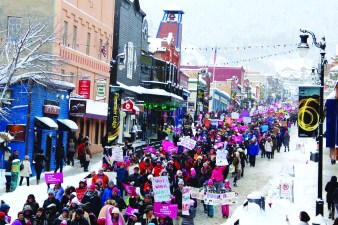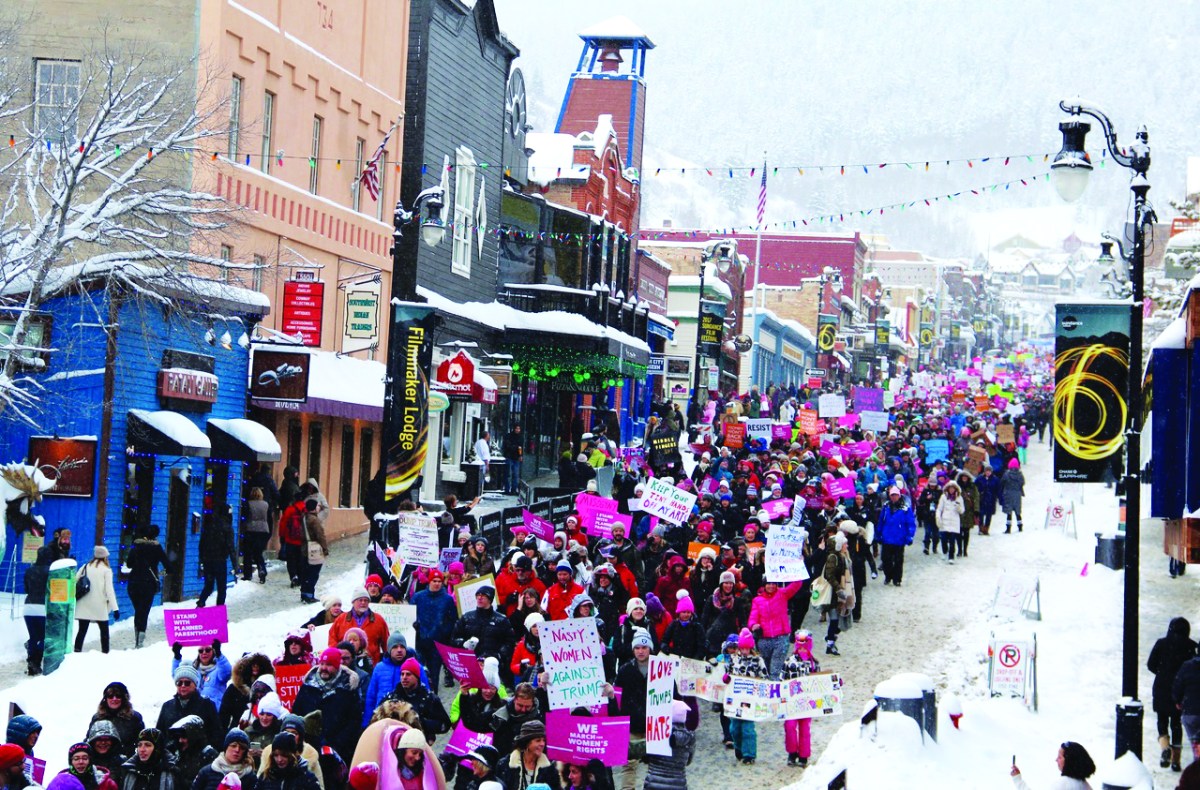
The Women’s March on Main Street, Jan. 21, 2017. (Photo by Nan Chalat-Noaker)
For those who have not experienced the Sundance Film Festival before, its impact on Park City can arguably be compared to a winter weather cyclone. But for a cadre of international film industry veterans, it has earned a reputation as a masterpiece of global creativity and energy.
To pull it off, Sundance and Park City draw on an army of tactical and logistical experts. The Sundance Institute rallies staff from both coasts and enlists a ground force of more than 2,000 volunteers while Park City officials issue an all-hands-on-deck alert calling on personnel from every department.
The two organizations’ successful, 30-year history of working together was especially apparent last year when the festival’s opening weekend collided with a political and meteorological maelstrom: the Women’s March and a record-breaking snowstorm. Enabled by the city’s experienced public safety professionals and enhanced by Sundance’s diverse creative community, images of Park City’s iconic Main Street jammed with more than 9,000 peaceful protestors buoyed hopes for a brighter future.
It was a day that few will forget and many will remember forever.
While organizers may be hoping for milder weather this January, the festival’s commitment to cultural awareness and individual expression is as strong as ever. This year’s slate touches on social issues from gender equality to climate change and includes forays beyond the frontier of filmmaking technology.
Still, even for the savviest movie buffs, negotiating Park City during Sundance, and the concurrent Slamdance Film Festival, is challenging. Aside from the vexing dilemma of which films to see, getting around the city requires careful planning.
Sundance Film Festival venues are spread throughout the city and Kimball Junction, with additional screenings also scheduled in Sundance and Salt Lake City. The slate, as always, offers a gluttonous feast of films from both well-known directors and first-timers, from A-list casts to as-yet-undiscovered stars. There are also virtual reality experiences to try, panels and parties to attend and meetings to be held — enough activity to fill a yearlong calendar much less to shoehorn into just 10 days.
Festival visitors and media outlets have also learned not to discount the smaller Slamdance Film Festival, founded 20 years ago by a pair of filmmakers whose project was rejected by Sundance. The upstart crew has maintained its foothold at The Treasure Mountain Inn at the top of Main Street and over the years it has launched a number of successful filmmakers’ careers.
This guide contains brief descriptions of the films and events hosted by both festivals as well. The overriding message is to plunge in — but preferably without a car. Park City’s buses and sidewalks hum with excitement during the festival and are great places to catch the buzz about breakout directors and performances, not to mention locals’ tips on where to eat, sleep and ski.
In these pages, we also try to convey Sundance’s year-round impact on Park City and the state. Since the festival’s inception, local residents have embraced their role in supporting Sundance’s mission to support independent artists and connect them with audiences. As a result, Parkites’ enthusiasm for film now extends long after the last reels and projectors have been packed up and trucked out of town.
Two notable outgrowths of Sundance’s influence are the Park City Film Series and the proposed arts and culture district that will house a new year-round Sundance facility. Both are explained in detail within this magazine.
We hope you have an inspiring experience in Park City during our annual immersion in independent film — and that you will consider returning for more, even after the banners and spotlights have been lowered.


